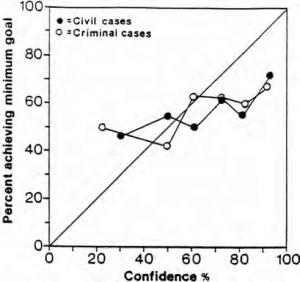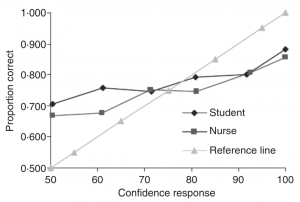|
|
| Line 10: |
Line 10: |
| This lesson continues the previous lesson, [[3.1 Probabilistic Reasoning]], and addresses the importance of the calibration of credence levels. We illustrate with some real-life examples that people, even experts, often exhibit overconfidence. By resolving the [[3.1 Probabilistic Reasoning#Future Predictions|Future Predictions]] activity from the previous lesson, we show the students how to improve their own calibration. Finally, with the Actively Open-minded Thinking and Growth Mindset surveys, we introduce psychological attitudes that can help motivate one to improve their calibration. | | This lesson continues the previous lesson, [[3.1 Probabilistic Reasoning]], and addresses the importance of the calibration of credence levels. We illustrate with some real-life examples that people, even experts, often exhibit overconfidence. By resolving the [[3.1 Probabilistic Reasoning#Future Predictions|Future Predictions]] activity from the previous lesson, we show the students how to improve their own calibration. Finally, with the Actively Open-minded Thinking and Growth Mindset surveys, we introduce psychological attitudes that can help motivate one to improve their calibration. |
|
| |
|
| <!-- Expandable section relating this lesson to earlier lessons. --> | | <!-- Expandable section relating this lesson to other lessons. --> |
| {{Expand|Relation to Earlier Lessons| | | {{Expand|Relation to Other Lessons| |
| | '''Earlier Lessons''' |
| {{ContextLesson|1.2 Shared Reality and Modeling}} | | {{ContextLesson|1.2 Shared Reality and Modeling}} |
| {{ContextRelation|Raft vs. pyramid: Having concrete methods to assess and calibrate credence levels allows scientists to comfortably discuss their imperfect results without being overly invested in ''being right''. This also leaves open the possibility that scientific claims can be revised or overturned in light of new evidence. This is a strength of the scientific method, rather than a weakness.}} | | {{ContextRelation|Raft vs. pyramid: Having concrete methods to assess and calibrate credence levels allows scientists to comfortably discuss their imperfect results without being overly invested in ''being right''. This also leaves open the possibility that scientific claims can be revised or overturned in light of new evidence. This is a strength of the scientific method, rather than a weakness.}} |
| {{ContextLesson|3.1 Probabilistic Reasoning}} | | {{ContextLesson|3.1 Probabilistic Reasoning}} |
| {{ContextRelation|The current lesson refines the previous one by introducing concrete ways to assess one's credence calibration and to improve upon them.}} | | {{ContextRelation|The current lesson refines the previous one by introducing concrete ways to assess one's credence calibration and to improve upon them.}} |
| }} | | {{Line}} |
| <!-- Expandable section relating this lesson to later lessons. -->
| | '''Later Lessons''' |
| {{Expand|Relation to Later Lessons|
| |
| {{ContextLesson|5.1 False Positives and Negatives}} | | {{ContextLesson|5.1 False Positives and Negatives}} |
| {{ContextRelation|With accurately calibrated credence levels, decisions can be made on whether to act upon a prediction by considering the seriousness of its consequences. For example, a city should invest heavily in storm protection even when there is a 10% confidence that a strong hurricane will hit the city.}} | | {{ContextRelation|With accurately calibrated credence levels, decisions can be made on whether to act upon a prediction by considering the seriousness of its consequences. For example, a city should invest heavily in storm protection even when there is a 10% confidence that a strong hurricane will hit the city.}} |


